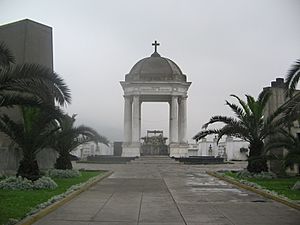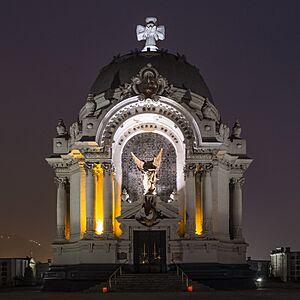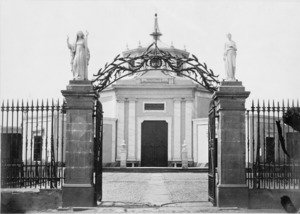Cementerio Presbítero Matías Maestro facts for kids
 |
|
| Details | |
|---|---|
| Established | 1810 |
| Location |
Lima District, Peru
|
| Owned by | Charity of Lima |
The Presbyter Matías Maestro Cemetery (in Spanish: Cementerio Presbítero Matías Maestro) is a very old and important place in Lima, Peru. It's not just a cemetery; it's also a museum and a historical monument. Located in the Barrios Altos area, it was the first official burial ground in Lima. Before it opened on May 31, 1808, people were usually buried inside or under churches.
This special cemetery is named after its designer, a Spanish priest named Matías Maestro. Inside, you can find 766 beautiful mausoleums and 92 historical monuments. These structures show amazing architecture from the 1800s and 1900s. Many important Peruvian leaders, soldiers, and writers are buried here. One of the most famous parts is the Crypt of Heroes, a large monument honoring those who fought in the War of the Pacific.
Contents
History of Lima's First Cemetery
The Presbyter Matías Maestro Cemetery was the very first public cemetery in all of America. When it was first planned, some people didn't like the idea. They were used to burying their loved ones in churchyards or in special rooms called crypts beneath churches.
The cemetery officially opened in 1808. The opening ceremony was led by Viceroy José Fernando de Abascal. The whole project was guided by Matías Maestro, who was an architect, sculptor, and painter from Spain. Maestro came to Peru in the late 1700s. By 1793, he became a Catholic Priest and started redesigning churches and altars in the popular Neoclassical style. He later became the head of Lima's Charity Society in 1826 and passed away in 1835.
The cemetery was designed with great care, following the new Neoclassical style. It featured a clear and organized layout with straight paths, chapels, and parks. An octagonal chapel was built, which was later taken down. Its inside walls were decorated with paintings by José del Pozo, a painter from Seville who worked closely with Maestro.
Art and Sculptures at the Cemetery
This cemetery is like an outdoor art gallery, filled with amazing sculptures. Many works were created by famous artists from different countries. You can see pieces by Spanish sculptors like Damià Campeny and Josep Campeny i Santamaria. French artists such as Louis-Ernest Barrias, Émile Robert, and Antonin Mercié also have works here, especially in the Crypt of Heroes.
Italian sculptors like Ulderico Tenderini, Giovanni Battista Cevasco, Pietro Costa, and Rinaldo Rinaldi also contributed. Peru's own talented sculptors from the mid-1900s are also represented. For example, Romano Espinoza created the monument for Luis Miguel Sánchez Cerro. Luis Agurto made the bronze sculptures for Óscar R. Benavides's mausoleum. Artemio Ocaña designed the mausoleum for Eloy G. Ureta, and Aldo Rossi created the angel for Francisco Graña's monument. Eduardo Gastelú made the Pastor Fry mausoleum. One notable sculpture is El Ángel de la Guarda (The Guardian Angel), created in 1947 by Isabel Benavides Barreda.
Crypt of Heroes
| Cripta de los Héroes | |

The mausoleum at night
|
|
| Designer | Emile Robert |
|---|---|
| Type | Mausoleum |
| Material | Stone, marble |
| Opening date | September 8, 1908 |
| Restored date | 2002 |
| Dedicated to | War of the Pacific |
The Crypt of Heroes (in Spanish: Cripta de los Héroes) is the biggest monument in the cemetery. It was built to remember all the brave people who died during the War of the Pacific. At its entrance, a message reads: "The Nation, to its Defenders in the War of 1879."
History of the Crypt
The idea for the Crypt of Heroes became a law on December 3, 1906. It was officially opened on September 8, 1908, when José Pardo y Barreda was the president. The architect Emile Robert designed this impressive structure using stone and marble. It has a unique mix of styles, known as eclectic, and is topped with a marble copy of the famous Gloria Victis sculpture by Antonin Mercié.
In 1953, the Crypt was placed under the care of the Center for Historical Military Studies of Peru, becoming a special Patriotic Sanctuary. To make room for more combatants, the monument was made larger in 1986 with a second basement. In 2002, the Crypt was carefully restored to look like it did when it was first built.
What the Crypt Looks Like
The Crypt of Heroes is a tall, round building, over 30 meters high. It has three levels: a main floor and two basements. A large dome sits on top, and the outside is decorated with beautiful ornaments and neoclassical columns. Inside, the walls are covered in shiny marble with black patterns, and there are colorful stained glass windows.
In total, the Crypt holds the remains of 295 identified heroes. Twenty-nine of these are in large stone coffins called sarcophagi, and 265 are in special wall compartments called niches. There are also 2,065 plaques on the walls with the names of other combatants or those whose identities are unknown.
Main Floor of the Crypt
The main floor is where you enter the mausoleum. It is beautifully decorated with marble. Here, you'll find the sarcophagi of Peru's greatest heroes from the war. These include Miguel Grau, a naval hero who died in the battle of Angamos on October 8, 1879, while on his ship, the Huáscar. Also here is Colonel Francisco Bolognesi, who bravely defended Arica and fell in battle on June 7, 1880. The walls also have marble plaques honoring people who helped or fought in the conflict.
First Basement of the Crypt
You can reach the first basement by a side staircase. This level has 234 niches where remains are buried all around the circular wall. In the center, you'll see the sarcophagus of Mariscal Andrés Avelino Cáceres, another important military leader. There are also five ossuaries, which are special containers holding the remains of unknown soldiers who died in various naval battles like Angamos, Iquique, Antofagasta, and Callao. Other remains are from battlefields such as Tarapacá, Tacna and Arica, San Juan and Chorrillos, Miraflores, and Huamachuco.
Second Basement of the Crypt
The lowest level of the Crypt has 29 sarcophagi, 16 plaques, and 40 white marble niches. These stand out against the black marble on the floor and walls. Here lie Alfonso Ugarte and other heroes of the War of the Pacific. The remains of Luis Alberto García Rojas were also buried here in 2019.
Important People Buried Here
Many famous and influential people from Peru's history are buried in the Presbyter Matías Maestro Cemetery.
Peruvian Presidents
- José de la Riva Agüero
- José de La Mar
- Agustín Gamarra
- Antonio Gutiérrez de la Fuente
- Manuel Salazar y Baquíjano
- Felipe Santiago Salaverry
- Juan Crisóstomo Torrico
- Juan Antonio Pezet
- Justo Figuerola
- Manuel Menéndez
- Manuel Ignacio de Vivanco
- José Rufino Echenique
- José Balta y Montero
- Miguel de San Román
- Manuel Pardo y Lavalle
- Mariano Ignacio Prado
- Nicolás de Piérola
- Lizardo Montero (in the Crypt of Heroes)
- Miguel Iglesias (in the Crypt of Heroes)
- Remigio Morales Bermúdez (in the Crypt of Heroes)
- Justiniano Borgoño (in the Crypt of Heroes)
- Andrés Avelino Cáceres (in the Crypt of Heroes)
- Manuel Candamo
- José Pardo y Barreda
- Guillermo Billinghurst
- Augusto B. Leguía
- Luis Miguel Sánchez Cerro
- Óscar R. Benavides
- Manuel Prado Ugarteche
- Ricardo Pérez Godoy
Other Notable Figures
- Politicians: Antonia Moreno Leyva (first lady), Victoria Tristán (first lady), Vicente Rocafuerte, Javier Diez Canseco, Luis A. Flores, José Gálvez Egúsquiza.
- Academics: José de la Riva-Agüero y Osma, Mariano Felipe Paz Soldán, Antonio Raimondi, Daniel Alcides Carrión, Cayetano Heredia, Javier Pérez de Cuéllar.
- Military Leaders: Alfonso Ugarte, Eloy G. Ureta, Clemente von Althaus, Manuel Bonilla Elhart.
- Artists and Writers: Felipe Pardo y Aliaga (writer), Manuel Ascencio Segura (writer), Manuel González Prada (writer), Ricardo Palma (writer), Abraham Valdelomar (writer), José Carlos Mariátegui (writer), José Santos Chocano (writer), Ciro Alegría (writer), José María Eguren (writer), César Moro (writer), Francisco Laso (painter), José Sabogal (painter), Víctor Humareda (painter), Felipe Pinglo Alva (composer), Carlos Hayre (composer), Rosa Merino (singer), Micaela Villegas (singer), Alejandro Villanueva (footballer).
- Architects, Engineers, and Businessmen: Matías Maestro, Edward Jan Habich, Ernest Malinowski, Henry Meiggs, Michele Trefogli, Manuel Piqueras Cotolí.
Images for kids
See also
 In Spanish: Cementerio Presbítero Matías Maestro para niños
In Spanish: Cementerio Presbítero Matías Maestro para niños
- Church of the Holy Christ of Wonders
- El Ángel Cemetery
- Nueva Esperanza Cemetery




